Musk said that the Semi would charge to 500 miles in 30 minutes. Is that from 0 or a certain percentage of remaining range to fully charged. So if you only charge to 80% to preserve battery life that is only 400 miles So if you go down to 5% then charge to 80% you have an effective range of about 380 miles. How long will it take to go from that 80% to a full charge? What will it taper down to to reach that full charge?
Welcome to Tesla Motors Club
Discuss Tesla's Model S, Model 3, Model X, Model Y, Cybertruck, Roadster and More.
Register
Install the app
How to install the app on iOS
You can install our site as a web app on your iOS device by utilizing the Add to Home Screen feature in Safari. Please see this thread for more details on this.
Note: This feature may not be available in some browsers.
-
Want to remove ads? Register an account and login to see fewer ads, and become a Supporting Member to remove almost all ads.
You are using an out of date browser. It may not display this or other websites correctly.
You should upgrade or use an alternative browser.
You should upgrade or use an alternative browser.
Charging the Semi
- Thread starter ThomasD
- Start date
Musk said that the Semi would charge to 500 miles in 30 minutes.
Where/when did Elon say that? I recall him saying that the Semi can charge 80% in 30 minutes. That could be 10% to 90% or 5% to 85%...
Sorry it was 400 miles in 30 minutes
AUTOS
Tesla’s new semi truck has a 500 mile range
PUBLISHED FRI, NOV 17 20171:35 AM ESTUPDATED FRI, NOV 17 20177:51 AM EST
Robert Ferris@IN/ROBERT-FERRIS-A482061/@ROBERTOFERRIS
KEY POINTS
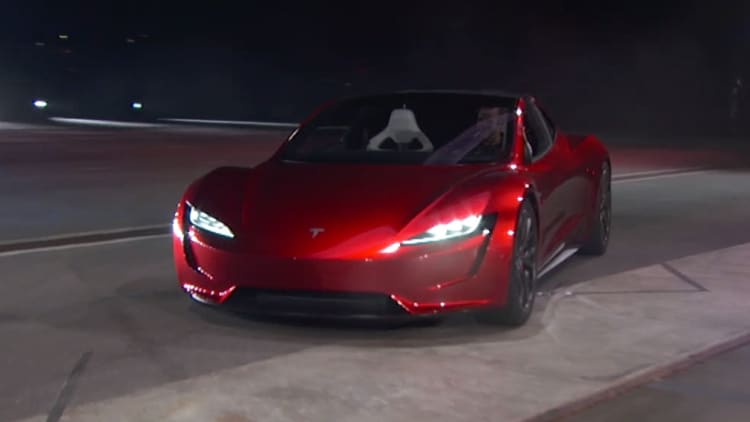
WATCH NOW
VIDEO01:54
Tesla surprised everyone at the semi truck unveiling with a revamped Roadster
Tesla unveiled the Tesla Semi truck on Thursday.
The truck can drive 500 miles on a single charge, which was higher than some analysts had expected. That may mean that, in terms of range, the vehicle could meet the needs of long haul truck drivers.
“That is 500 miles at maximum weight, at highway speed, so you are doing 60 mph,” Tesla CEO Elon Musk told a crowd in Los Angeles Thursday night. “That is the worst case scenario.”
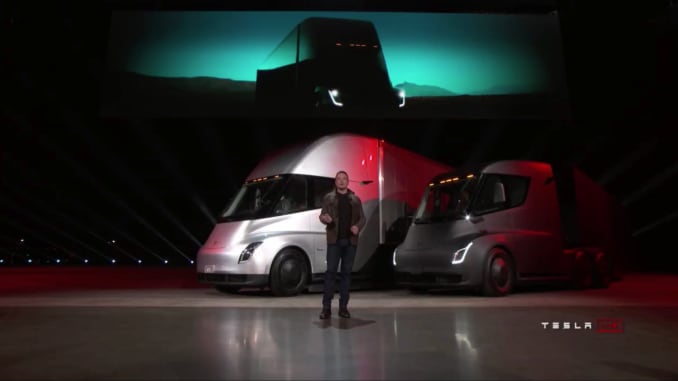
SOURCE: Tesla
Musk said the truck can beat a diesel truck in a straight line, up a 5 percent grade, and even without two of its four independent motors functioning.
The truck can go from 0-60 in 5 seconds by itself, or in 20 seconds with an 80,000 pound load.
And Musk said the truck will beat diesel trucks in terms of price per mile when the total cost of ownership is factored in, Musk said.
Musk also said the truck drives far more easily than diesel trucks.
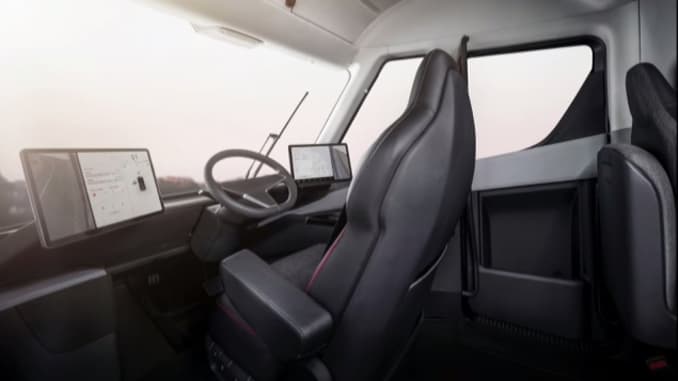
The interior of the Tesla Semi
Tesla
Every truck will come with Autopilot standard. The truck’s low center of gravity will make it difficult for the truck to rollover, and impossible to jack-knife, Musk said.
Tesla will also build a network of Tesla “Megachargers” that will charge the trucks’ batteries to a 400 mile range in 30 minutes.
The company will guarantee the truck will not break down for 1 million miles, Musk said.
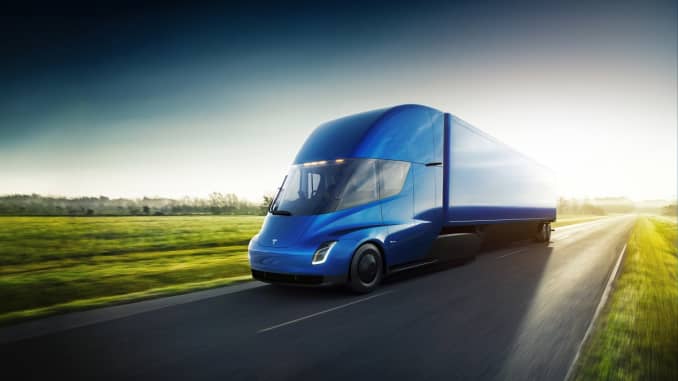
A Tesla Semi electric transport truck.
Source: Tesla
“We are guaranteeing it won’t break down for a million miles because it has four independent motors,” Musk said. “You can lose 2 of those 4 motors and the truck will still keep going.”
Musk said a convoy of Tesla Semi trucks would even be more economical than freight by rail.
Analysts have expressed some skepticism that any electric truck can currently compete with the diesel trucks that dominate commercial trucking. Unlike luxury car buyers, trucking companies are primarily concerned with which trucks make most sense for their own financial bottom line.
“The biggest challenge Tesla faces with its semi is customers,” said Rebecca Lindland, executive analyst at Kelley Blue Book. “These are business people not fans, and they will need convinced that this truck is better for their balance sheet than existing technology. It probably is, based on the specs provided, but this isn’t necessarily a slam dunk.”
Tesla unveils its bid at a commercial truck as it faces other challenges, particularly around the production of its Model 3 sedan.
The company reported its biggest quarterly loss in history in the third quarter, weeks after saying it had fallen far short of its delivery targets for the Model 3.
As it attempts to address what Tesla has called “production bottlenecks” and boost production, Tesla has faced some criticism over its relationship with some members of its workforce.
AUTOS
Tesla’s new semi truck has a 500 mile range
PUBLISHED FRI, NOV 17 20171:35 AM ESTUPDATED FRI, NOV 17 20177:51 AM EST
Robert Ferris@IN/ROBERT-FERRIS-A482061/@ROBERTOFERRIS
KEY POINTS
- Tesla Semi truck will have a higher range than some expected
- The Semi is more economical than diesel when factoring in the total cost of owning, said CEO Elon Musk

WATCH NOW
VIDEO01:54
Tesla surprised everyone at the semi truck unveiling with a revamped Roadster
Tesla unveiled the Tesla Semi truck on Thursday.
The truck can drive 500 miles on a single charge, which was higher than some analysts had expected. That may mean that, in terms of range, the vehicle could meet the needs of long haul truck drivers.
“That is 500 miles at maximum weight, at highway speed, so you are doing 60 mph,” Tesla CEO Elon Musk told a crowd in Los Angeles Thursday night. “That is the worst case scenario.”

SOURCE: Tesla
Musk said the truck can beat a diesel truck in a straight line, up a 5 percent grade, and even without two of its four independent motors functioning.
The truck can go from 0-60 in 5 seconds by itself, or in 20 seconds with an 80,000 pound load.
And Musk said the truck will beat diesel trucks in terms of price per mile when the total cost of ownership is factored in, Musk said.
Musk also said the truck drives far more easily than diesel trucks.

The interior of the Tesla Semi
Tesla
Every truck will come with Autopilot standard. The truck’s low center of gravity will make it difficult for the truck to rollover, and impossible to jack-knife, Musk said.
Tesla will also build a network of Tesla “Megachargers” that will charge the trucks’ batteries to a 400 mile range in 30 minutes.
The company will guarantee the truck will not break down for 1 million miles, Musk said.

A Tesla Semi electric transport truck.
Source: Tesla
“We are guaranteeing it won’t break down for a million miles because it has four independent motors,” Musk said. “You can lose 2 of those 4 motors and the truck will still keep going.”
Musk said a convoy of Tesla Semi trucks would even be more economical than freight by rail.
Analysts have expressed some skepticism that any electric truck can currently compete with the diesel trucks that dominate commercial trucking. Unlike luxury car buyers, trucking companies are primarily concerned with which trucks make most sense for their own financial bottom line.
“The biggest challenge Tesla faces with its semi is customers,” said Rebecca Lindland, executive analyst at Kelley Blue Book. “These are business people not fans, and they will need convinced that this truck is better for their balance sheet than existing technology. It probably is, based on the specs provided, but this isn’t necessarily a slam dunk.”
Tesla unveils its bid at a commercial truck as it faces other challenges, particularly around the production of its Model 3 sedan.
The company reported its biggest quarterly loss in history in the third quarter, weeks after saying it had fallen far short of its delivery targets for the Model 3.
As it attempts to address what Tesla has called “production bottlenecks” and boost production, Tesla has faced some criticism over its relationship with some members of its workforce.
How long do you think it would take to charge to 500 miles? If an 80% charge to 400 miles is 30 minutes. If you are running down to 10 to 20 percent of range then charging to just 80 percent you will be charging this thing a lot. I wish they would give a few trucks to some of the people that ordered them to get input on what would need to be improved.
SmartElectric
Active Member
If an 80% charge to 400 miles is 30 minutes. If you are running down to 10 to 20 percent of range then charging to just 80 percent you will be charging this thing a lot
20%-80% is 60% of 500 mile range = 300 miles
At 60 mph, that's 5 hours of driving before charging, not sure I agree that is "a lot".
ie. Start day fully charged overnight (at depot) = 500 miles.
Drive 6 hours at 60 mph = 360 miles = 28% SOC or 140 miles remaining.
Assume : charging at 400 miles in 30 minutes (claimed up thread by someone else) = ~13.3 miles/minute.
Stop for 20 minutes, add 260 miles range to 140 = 400 miles range remaining.
Drive 6 hours at 60 mph = 360 miles or 40 miles remaining = empty battery.
Re-charge overnight at depot/destination.
Result : 720 mile trip with 12 hours total driving and one 20 minute charging stop.
=NOT "a lot"
Last edited:
I guess it would also depend on the load A box trailer would have less drag than a low boy carrying a Cat D11R Will high drag loads affect the Tesla Semi worse than a Diesel Semi towing the same loads. Or would they be the same
adiggs
Well-Known Member
At 60 mph, that's 5 hours of driving before charging, not sure I agree that is "a lot".
With the additional challenge that this particular conversion of energy into transport is built on ideal driving circumstances. Which is nice, but buyers of income producing assets won't be able to make their truck purchase decisions on the ideal situation; they'll need to buy capability that will handle at least 90% of their driving circumstances, and maybe more like 99% (or even more 9's).
If heavy rain / headwind increases energy consumption by 50%, that turns a 500 mile range truck into a 333 mile range truck. What effect does snow and ice have on range? I don't know what the actual change in energy consumption will be, but I figure fleet buyers will be testing this with particular focus when they get their test trucks.
This is also why I foresee a significantly longer ranged truck in the future - maybe after battery improvements, but a 1.5MWh / 750 mile range truck will handle non-ideal circumstances better, charge faster (or at least longer at full speed), and have more buffer to handle charge times that fit inside of an hours-of-service mandated break time and still enable full travel time within the hours-of-service constraints.
(And what will it take to enable team driving of an electric semi!?!)
adiggs
Well-Known Member
The ultimate OTR Semi Team driving with your spouse/partner
Uhm - wow.
SmartElectric
Active Member
If heavy rain / headwind increases energy consumption by 50%, that turns a 500 mile range truck into a 333 mile range truck. What effect does snow and ice have on range? I don't know what the actual change in energy consumption will be, but I figure fleet buyers will be testing this with particular focus when they get their test trucks
Range is a useful measurement, but cost is the key.
500 mile range was quoted as maximum gross weight/capacity at 60 mph.
Snow and ice affect diesel and electric drive trains, but less for Tesla due to aero efficiency, advantage Tesla.
Price per gross weight mile will be the differentiation, if Tesla is cheaper as they claim, it will sell in numbers.
adiggs
Well-Known Member
Range is a useful measurement, but cost is the key.
500 mile range was quoted as maximum gross weight/capacity at 60 mph.
Snow and ice affect diesel and electric drive trains, but less for Tesla due to aero efficiency, advantage Tesla.
Price per gross weight mile will be the differentiation, if Tesla is cheaper as they claim, it will sell in numbers.
Cost is the key (I totally agree with that) given that the vehicle can do the job at all. I figure trucks cover about 600 miles/day with a single driver. I'm not conversant with the details of hours-of-service regulations, but they matter here. 600 miles/day is about 10 hours of driving (I know HOS is > 10 hours) is more than the 500 mile pack can support.
So we'll need to charge during the day. If we'll end up somewhere the truck can charge overnight, then a single charger somewhere in the middle of that day's drive will work, as long as it charges fast enough (mega charger) to get enough incremental range, fast enough. My mental model is that the determinant of 'fast enough' is the length of the mandated break within the HOS. If enough charging happens during the break, then there's no lost time for the driver. That probably also means that the truck stop will need more total charging bays as you'll want more time charging than current trucks consume by pumping diesel.
Anyway, it's these days where the truck is intended to be covering ground most of the day, plus non-ideal circumstances, where I think even the 500 mile truck is a milestone / waypoint on the way to a longer range truck that can fit how trucks get used today (or at least, more of the use cases trucks have today).
And then there's still the team drivers. I don't know how HOS affects team drivers - are the trucks effectively in motion full time? If so, charging is going to be challenging (in the context of keeping the truck moving ~full time. Easy enough to just say that the electric truck isn't ready for that use case - there's plenty of other truck market to build for
And then there's still the team drivers. I don't know how HOS affects team drivers - are the trucks effectively in motion full time? If so, charging is going to be challenging (in the context of keeping the truck moving ~full time. Easy enough to just say that the electric truck isn't ready for that use case - there's plenty of other truck market to build for
Sure you could say that the Tesla Semi isn't ready for that market yet. But on the other hand what happens to those team drivers when someone can get their shipment from a Tesla Semi 1 day later at ~50% of the cost? In some cases it would be worth the extra money for faster shipping, but I think in most cases the cost of shipping will win.
roblab
Active Member
Interesting that all these scenarios are built on long range driving, when probably half of all semi miles are short haul, maybe more. True, long haulers do a lot of miles, but rail covers a lot of miles, and I've seen rail with over a hundred semi trailers on the flatcars. Usually the long haul goes by rail, then the semis are off loaded to be moved by truck to the local businesses. As the article said, rail is still cheaper.
I've driven a semi back in the day. Boring, until some Prius pulls in front of you and hits the brakes AND the road is wet. Times like that, I'd appreciate the weight on the rear drivers so it wouldn't jack knife. Wish I could have driven an electric!
And just because it might take a half an hour to refill the battery 80% doesn't mean it's not competitive time-wise. Very seldom did I see semi drivers hurrying inside for more Slim Jims and then racing out to drive away as soon as the tanks were filled. Them tanks take a while to fill, too, even when using two pumps at a time. And I've never noticed truck drivers pulling over just because they'd run their ten hour shift.
I've driven a semi back in the day. Boring, until some Prius pulls in front of you and hits the brakes AND the road is wet. Times like that, I'd appreciate the weight on the rear drivers so it wouldn't jack knife. Wish I could have driven an electric!
And just because it might take a half an hour to refill the battery 80% doesn't mean it's not competitive time-wise. Very seldom did I see semi drivers hurrying inside for more Slim Jims and then racing out to drive away as soon as the tanks were filled. Them tanks take a while to fill, too, even when using two pumps at a time. And I've never noticed truck drivers pulling over just because they'd run their ten hour shift.
adiggs
Well-Known Member
Interesting that all these scenarios are built on long range driving, when probably half of all semi miles are short haul, maybe more. True, long haulers do a lot of miles, but rail covers a lot of miles, and I've seen rail with over a hundred semi trailers on the flatcars. Usually the long haul goes by rail, then the semis are off loaded to be moved by truck to the local businesses. As the article said, rail is still cheaper.
I've driven a semi back in the day. Boring, until some Prius pulls in front of you and hits the brakes AND the road is wet. Times like that, I'd appreciate the weight on the rear drivers so it wouldn't jack knife. Wish I could have driven an electric!
And just because it might take a half an hour to refill the battery 80% doesn't mean it's not competitive time-wise. Very seldom did I see semi drivers hurrying inside for more Slim Jims and then racing out to drive away as soon as the tanks were filled. Them tanks take a while to fill, too, even when using two pumps at a time. And I've never noticed truck drivers pulling over just because they'd run their ten hour shift.
Actual information - far more valuable than guesswork and speculation (me <----).
electracity
Active Member
Musk said that the Semi would charge to 500 miles in 30 minutes. Is that from 0 or a certain percentage of remaining range to fully charged. So if you only charge to 80% to preserve battery life that is only 400 miles So if you go down to 5% then charge to 80% you have an effective range of about 380 miles. How long will it take to go from that 80% to a full charge? What will it taper down to to reach that full charge?
The semi will mostly be a number of separate battery packs that can be charged individually. So charging performance will likely be somewhat similar to cars, assuming enough watts are available to do all the packs at once.
Longer lasting cell chemistry for the semi may reduce charge rate somewhat, but I still expect the semi to have charge performance more similar to cars than not.
I don't see charge time as being particularly limiting. I see the large energy requirement and the cost of electricity at the time of charging are more problematic.
I think there is a good use case for a significant number of semis today. I doubt Tesla has the cells to make the trucks.
SmartElectric
Active Member
The semi will mostly be a number of separate battery packs that can be charged individually
Evidence?
No Tesla to date has been designed as separate "packs".
You clearly used the word "packs" and not modules.
Care to clarify?
Watts_Up
Well-Known Member
The semi will mostly be a number of separate battery packs that can be charged individually.
Well, during the Semi Presentation, someone was able to open the charging door showing multiple plugs next to each other.Evidence?
No Tesla to date has been designed as separate "packs".
You clearly used the word "packs" and not modules.
Care to clarify?
So, if each plug is connected to a 100 kWh battery, you have a total of 800 kWh battery.
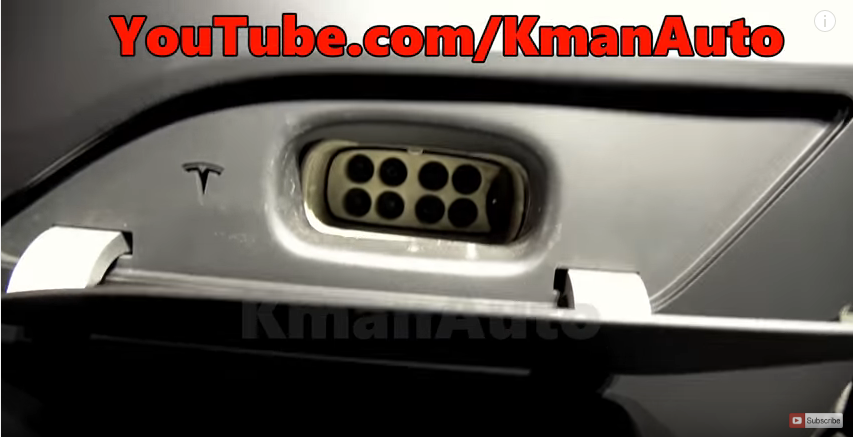
The following is an example of the latest 250 kW Supercharger. This location has 5 units of 1 mega Watts each.
And each unit is connected to 4 DC SuperCharger stations of 250 kW each. So there is a total of 20 stations of 250 kW.
May be just a speculation, but I would not be surprise if Tesla starts making specialized locations for Semi,
where one of those 1 mega Watts unit would be used for a single Semi using a special 1 Mega Watts cable.
The units would be distant enough so the Semi would not need to disconnect the trailer.

In the interval, it would not be impossible also that a Semi could use 4 DC SuperCharger stations using a set of 4 extension cables.
Tesla would be able to make reservation in advance so the stations would not be occupied by cars when a Semi would arrive.

Last edited:
It's actually 350kW cabinet plus 575kW of "DC sharing", not the advertised 1MW-with-no-sharing.5 units of 1 mega Watts each.

Supercharger V3 unveiling in Fremont
"no more splitting power with a vehicle in the stall next to you" may actually means "splitting power with all vehicles on site..."
electracity
Active Member
Well, during the Semi Presentation, someone was able to open the charging door showing multiple plugs next to each other.
So, if each plug is connected to a 100 kWh battery, you have a total of 800 kWh battery.
The only downside of having separate packs is managing voltage differences. I expect max config to be four packs, with the largest charger using four of the V3 charging modules. 100kWh packs seems too small. Around a megawatt of charging feels right as their design target. I don't see the need to divide cells into more than four packs.
I would be shocked if the V3 supercharger hardware is not reconfigured to charge the semi. But I definitely don't mean that semis would use the current supercharger sites.
Similar threads
- Replies
- 4
- Views
- 693
- Replies
- 15
- Views
- 926
- Replies
- 3
- Views
- 661
- Replies
- 7
- Views
- 481


